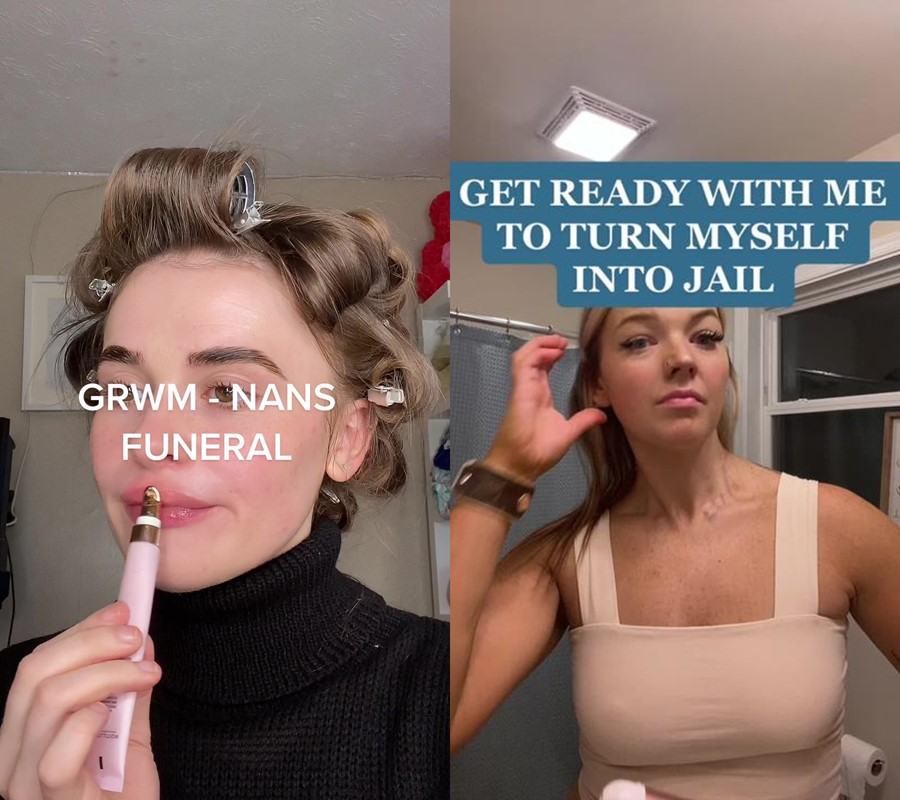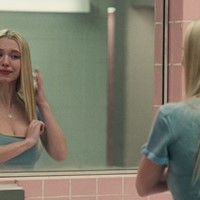From sharing stories about fentanyl addictions while applying concealer to make-up routines for funerals, ‘Get Ready With Me’ videos are becoming deeply personal
“Get ready with me and let’s talk about my fentanyl use,” begins a TikTok posted by model Mae Van Der Weide last month. The video, which has since been watched 4.5 million times, sees her candidly discuss her addiction, eating disorder and depression while dabbing spots of concealer on her face.
Sharing deeply personal experiences like this has become commonplace on TikTok. Whether it’s concealing tear-stained cheeks for a funeral, applying soft glam for a reunion with an ex or even touching up eyebrows before going to prison, creators are turning their beauty rituals into a vehicle to vent information once considered private to an audience of millions. These ‘Get Ready With Me’ (GRWM) videos have become the default for sharing stories and monologues otherwise reserved for encoded voice notes to close friends.
27-year-old make-up artist Tilly Ferrari stumbled upon this confessional format when she posted a video getting ready to see her ex, who was en route to pick up his belongings from her flat. “I needed to talk to someone. I was flustered and I hadn’t had anyone to bounce these things off,” she says. “So, I just put my phone on and pretended I was on FaceTime.” In the video, she litters make-up tips (“I’ve really been enjoying lining my lips with my brow pencil”) in between sporadic admissions of anxiety. It quickly went viral, her fleeting moment of panic now immortalised through a comment section as curious about the bronzer she uses as the details of her break-up.
But what is it about getting ready that triggers a desire to divulge? There’s a sense of intimacy inherent to our beauty routines, reminiscent of dimly-lit makeovers in teenage bedrooms or foundation touch-ups in club bathrooms. These sacred spaces see lipgloss swapped between strangers and territory at the mirror claimed to primp, preen and trade enthusiastic compliments. It’s essentially the ‘backstage’ of our lives – a place to unload the most troubling (or mundane) thoughts, with an in-built excuse to avoid eye contact.
This comfortable, yet deeply confessional, aspect of GRWMs feeds into what Dr Melanie Kennedy, a media and communications lecturer specialising in femininity in popular culture at the University of Leicester, describes as the digital evolution of “girls’ bedroom culture”. “Girls have always used the space of the bedroom to reveal very personal things to their friends,” she explains. Although GRWMs long predate TikTok and the pandemic, going back to the golden days of YouTube beauty gurus, when accessing physical environments became impossible during the lockdowns, digital outlets cropped up as replacements. “The pandemic exacerbated all of this because people turned to social media when they were stuck in their homes as an outlet for how they were feeling, and to stay connected with people.”
Three years later, hyper-confessional GRWMs have become a staple of the TikTok landscape. The app’s ever-changing algorithm means any video has the potential to be swept in front of audiences of millions, even if the creator hasn’t established a large following prior. It’s a sharp contrast to the 2010s influencer era, where follower bases and communities were grown more gradually over more extended periods, and there was an opportunity to build trust with an audience before sharing intimate information. “What’s changed is that it’s now hyper-visible,” Dr Kennedy says. “The very boundaries between what we traditionally understood as public and private have become blurred.”
In January, 17-year-old Sophie Thomas posted a video getting ready to break up with her boyfriend in which she details the downfall of their relationship as she blends a soft layer of liquid blush across her cheeks. She suggests that the familiarity of her routine lays the foundation to bare all. “I’m doing something that I’m already comfortable with, so that’s a safe spot to share a story,” she says. “It’s also the culture of connecting on TikTok. Since I’m not the only one sharing my personal life, it isn’t a big deal.”
@rufarozimbudzi lunch date with mums
♬ go (Higher & Faster) - Cat Burns
This fight for connection in an increasingly digitised world seems to be a common sentiment. Having posted a video of the beauty routine she follows when recovering from a depressive episode, Rufaro Zimbudzi, 19, says the phantom presence of the viewer conjures a sense of community during a part of her day usually mired in solitude. “It becomes a shared experience,” she says. “Feeling alone can perpetuate my depressive episodes, so when I get ready and invite others to join me, I know that someone, somewhere in a similar position is feeling less alone.”
YouTube tutorials in the 2010s were distinctive in their aesthetic of flaw-absorbing lighting, studio backgrounds and professional editing. TikTok’s take, on the other hand, often sees creators barely awake, pushing a headband through a tangled bed head and revealing a constellation of pimple patches applied the night before. On a platform where this level of authenticity (performed or real) is championed, content creators are keen to highlight the – often painful – realities of daily life. It’s why Maggie Nowers, 24, filmed her make-up routine the morning of her granddad’s funeral.
“I want to share the bad days as well as the good days," she says. Despite admitting an initial apprehension to click ‘post’, she says that weaving her personal life into her content and appearing on camera pre-grooming is integral to establishing a bond with viewers. “It’s that FaceTime effect,” she says. “If you can capture that on video, people are more likely to engage.”
Ranging from mundane oversharing to confessions that eclipse even the most scandalous reality TV plots, GRWMs set the tone for a new digital era where oversharing is synonymous with connecting, and where social media encourages us to turn our lives into content for consumption. Ferrari thinks so, reflecting fondly on the sorrow of her initial video. “I’m definitely a better person having documented it,” she says, adding with a laugh: “besides, what better way to get over heartbreak than to monetise it?”




